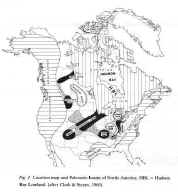Geologie en Mijnbouw 68(1989), 25-34
THE HUDSON BAY LOWLAND: MAJOR GEOLOGIC FEATURES AND ASSETS
I. PETER MARTINI
Department of Land Resource Science, University of Guelph, Guelph, Ont. NlG
2Wl, Canada
¡¡
 The Hudson Bay Lowland is a vast (325,000 km2), flat (average
slope 0.5m/km) physiographic region of Canada located to the southwest of James
Bay and Hudson Bay. It is underlain by Paleozoic and Mesozoic rocks and bounded
by Precambrian terrains. Thin Pleistocene till sheets, locally deposited on
fluted terrains mantle most of the Lowland, and they are overlain by thin marine
and coastal Holocene deposits which have formed during the ongoing regression
from an early post-glacial sea, the Tyrrell sea. The present shores of the James
Bay and Hudson Bay are but one stage of development of such regressive
sequences. More than 90% of the vast emerged Lowland is covered by one of the
largest cold wetlands and peatlands of the world. Up to 3-4 m thick peats have
developed in the last 5000 years in inland fens and raised bogs.
The Hudson Bay Lowland is a vast (325,000 km2), flat (average
slope 0.5m/km) physiographic region of Canada located to the southwest of James
Bay and Hudson Bay. It is underlain by Paleozoic and Mesozoic rocks and bounded
by Precambrian terrains. Thin Pleistocene till sheets, locally deposited on
fluted terrains mantle most of the Lowland, and they are overlain by thin marine
and coastal Holocene deposits which have formed during the ongoing regression
from an early post-glacial sea, the Tyrrell sea. The present shores of the James
Bay and Hudson Bay are but one stage of development of such regressive
sequences. More than 90% of the vast emerged Lowland is covered by one of the
largest cold wetlands and peatlands of the world. Up to 3-4 m thick peats have
developed in the last 5000 years in inland fens and raised bogs.
Fresh water is the major resource of the area, both for
hydroelectric power and/or irrigation on a continent wide scale. Other resources
not yet fully evaluated, consist of mineral deposits on or near Precambrian
inliers, hydrocarbons in the relatively thin Paleozoic sequence, and lignite,
kaolin and quartz sand in Mesozoic terrains.
The damage generated
by any development in the area, must be carefully weighted against the worldwide
importance of this vast peatland on gaseous fluxes and atmospheric balance.
Furthermore the coastal zone of the Lowland is a major staging and breeding
ground for polar bears, migratory birds and other species. Perhaps assurance of
preservation of the still pristine natural Hudson Bay Lowland should be achieved
by establishing it as an international heritage park.